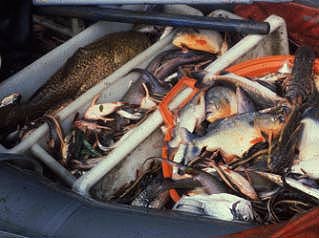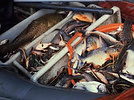Ostariophysi



This tree diagram shows the relationships between several groups of organisms.
The root of the current tree connects the organisms featured in this tree to their containing group and the rest of the Tree of Life. The basal branching point in the tree represents the ancestor of the other groups in the tree. This ancestor diversified over time into several descendent subgroups, which are represented as internal nodes and terminal taxa to the right.

You can click on the root to travel down the Tree of Life all the way to the root of all Life, and you can click on the names of descendent subgroups to travel up the Tree of Life all the way to individual species.
For more information on ToL tree formatting, please see Interpreting the Tree or Classification. To learn more about phylogenetic trees, please visit our Phylogenetic Biology pages.
close boxNotes about Terminal Taxa
The Gonorynchiformes includes two modern Indo-Pacific species (Chanos chanos, Gonorynchus gonorynchus) placed in monotypic families. Several fossils are assigned to the Chanidae and Gonorynchidae (Patterson, 1975, 1987), the oldest of which are early Cretaceous. There are 24 extant gonorynchiform species in the African freshwater family Kneriidae.
Characins, catfishes, electric (knife) fishes, carps and loaches comprise a well-known higher teleostean lineage named Otophysi (Ostariophysi in older literature). This clade accounts for over 25% of modern fish species (Nelson, 1994), and most of these live exclusively in freshwater.
Discussion of Phylogenetic Relationships
Otophysan monophyly is supported by several synapomorphies of which the best known are auditory specializations of the inner ear, anterior vertebrae (the Weberian complex), and gas bladder. Greenwood et al. (1966) and Rosen and Greenwood (1970) found related modifications of the gas bladder and other structures in the Gonorynchiformes. Rosen and Greenwood (1970) united the gonorynchiforms with characins, catfishes, cypriniforms and knife fishes into Ostariophysi, and coined the new name Otophysi for the more traditional assemblage (i.e. less gonorynchiforms). The hypothesis of sister taxon relationship between the Gonorynchiformes and Otophysi has held up under subsequent study.
In 1981 Fink and Fink published a cladistic study of the Otophysi that significantly departed from traditional concepts of interrelationships. A clade uniting Gymnotiformes plus Siluriformes was proposed to be the sister lineage of Characiforms, and these three are the sister taxon of the Cypriniformes.
References
Fink, S. V. and W. L. Fink. 1981. Interrelationships of the ostariophysan fishes (Teleostei). Zool. J. Linn. Soc. 72: 297-353.
Greenwood, P. H., D. E. Rosen, S. H. Weitzman and G. S. Myers. 1966. Phyletic studies of teleostean fishes, with a provisional classification of living forms. Bull. Amer. Mus. Nat. Hist. 131:339-455.
Patterson, C. 1975. The distribution of Mesozoic freshwater fishes. Pp. 156-174. In Biogéographie et liaisons intercontinentales au cours du Mésozoïque. Mém. Mus. Natl. d'Hist. Nat. nouv. sér., Paris, sér. A, Zool. 88.
Patterson, C.1984. Chanoides, A Marine Eocene Otophysan Fish (Teleostei: Ostariophysi). J. Vert. Paleontol. 4:430-456.
Rosen, D. and P. H. Greenwood. 1970. Origin of the Weberian apparatus and relationships of the ostariophysan and gonorynchiform fishes. Am. Mus. Novit. 2468:1-49.
About This Page
Page copyright © 1995 John G. Lundberg
 Page: Tree of Life
Ostariophysi.
The TEXT of this page is licensed under the
Creative Commons Attribution-NonCommercial-ShareAlike License - Version 3.0. Note that images and other media
featured on this page are each governed by their own license, and they may or may not be available
for reuse. Click on an image or a media link to access the media data window, which provides the
relevant licensing information. For the general terms and conditions of ToL material reuse and
redistribution, please see the Tree of Life Copyright
Policies.
Page: Tree of Life
Ostariophysi.
The TEXT of this page is licensed under the
Creative Commons Attribution-NonCommercial-ShareAlike License - Version 3.0. Note that images and other media
featured on this page are each governed by their own license, and they may or may not be available
for reuse. Click on an image or a media link to access the media data window, which provides the
relevant licensing information. For the general terms and conditions of ToL material reuse and
redistribution, please see the Tree of Life Copyright
Policies.
Citing this page:
Tree of Life Web Project. 1995. Ostariophysi. Version 01 January 1995 (under construction). http://tolweb.org/Ostariophysi/15077/1995.01.01 in The Tree of Life Web Project, http://tolweb.org/








 Go to quick links
Go to quick search
Go to navigation for this section of the ToL site
Go to detailed links for the ToL site
Go to quick links
Go to quick search
Go to navigation for this section of the ToL site
Go to detailed links for the ToL site